This is a walk down “memory lane” as I relate what it was like growing up as a young boy in the early 1970’s. I was in my early teenage years. I went to school, watched a lot of television, and played with my friends. Enjoy…
Introduction
As strange as it seems, there is very little on the internet about what it was like growing up in the 1960’s and 1970’s. It’s almost as if it was scrubbed from existence. In it’s place we now have the Obama narrative of a racist nation and terrible injustices. That narrative has nothing to do with reality. It is a scripted lie intended to manipulate people into believing something that just isn’t true.
Here, in my own little way, I would like to relate some stories of what it was like for me growing up as a kid. For “shits and giggles” I have chosen the year of 1971. It was the last year that I had as a kid before I had to go out and work at 14 in the coal mines.
This narrative takes place in Western Pennsylvania. We lived in a small town about a two hour drive from Pittsburgh. It was a hilly and tree shaded world, with railroad spur lines that snaked in and out of the hills and crossed over viaducts and into tunnels. I well knew those lines as I would often walk along them with my friends on hikes and adventures.
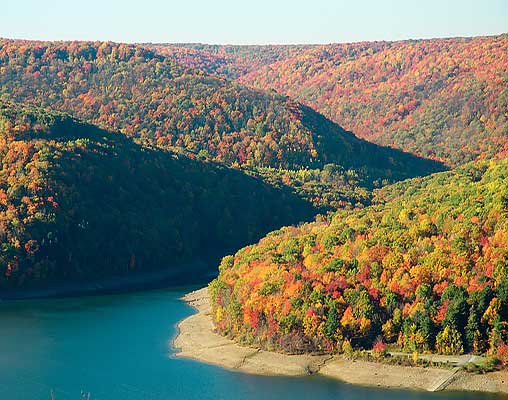
Visiting my Aunties
Many weekends my parents would drive into Pittsburgh to visit my relatives. Both were from Pittsburgh, though from different areas. We would take turns visiting the families. In the morning we would visit my father’s family, and in the afternoon we would visit my mother’s family.
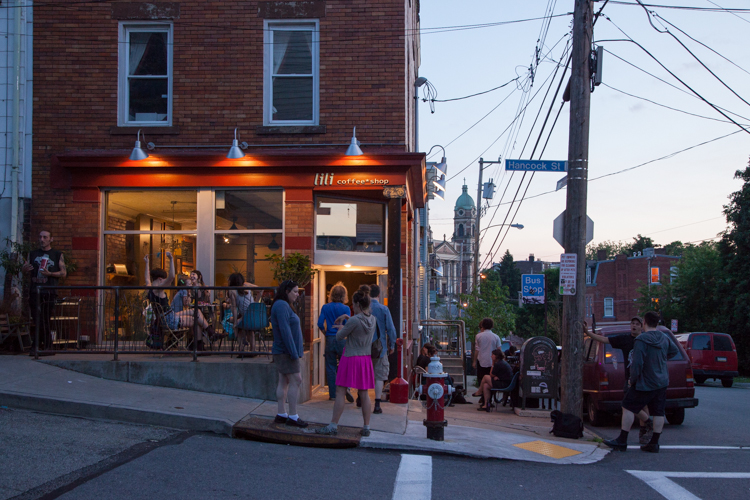
Often times, there would be other relatives that would come and say hi. I would see my grandparent’s brothers and sisters, my great aunts and uncles, if you will. And I might be persuaded to go with them to their homes. For some reason, the homes always smelled like bacon and cabbage.
There was always a pot of coffee on the stove. If it was cold they would either reheat it or make a fresh pot. The coffee pot was a percolator design. The water would start to boil and would be forced up through a metal straw into a container that held coffee grounds. You could control how strong the coffee was by the amount of ground in the upper container and how long your brewed the coffee. There was this glass bubble on the top of the coffee pot that you could watch to tell if the coffee was ready or not.
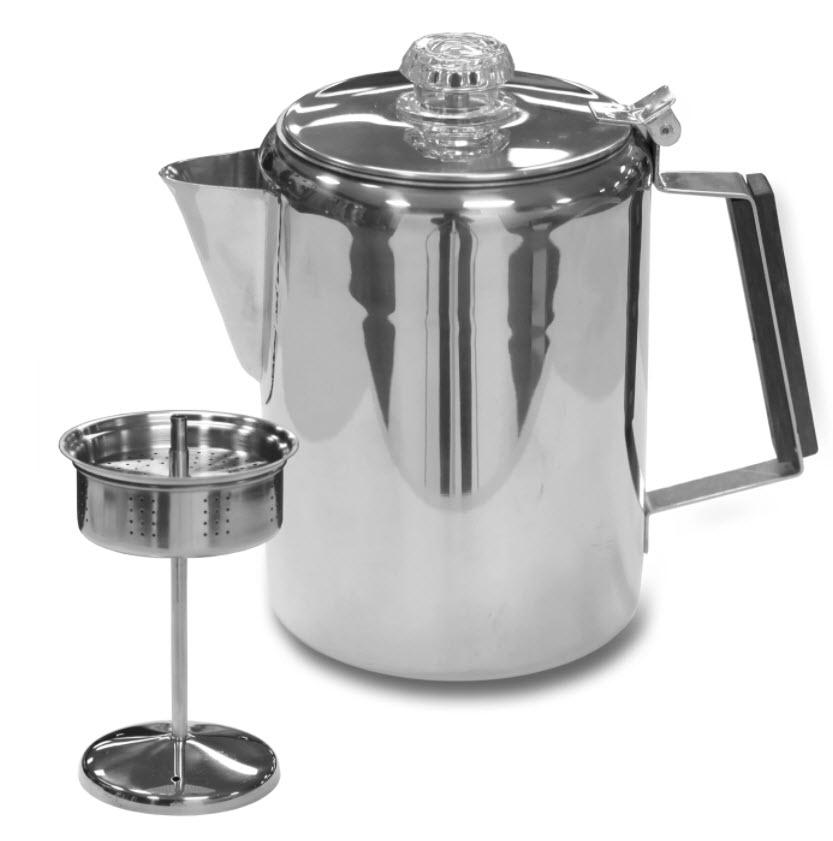
They would almost invariably offer me a cup of coffee and a bowl of what ever is cooking on the stove. There was something always cooking. Sometimes it was spaghetti sauce, sometimes it was chili. Sometimes it was “pigs in a blanket” (pork wrapped up in cabbage). Sometimes it was chicken soup. I could always eat my fill when I visited my aunties.
Of course, every single relative had this painting of “the last supper” on the wall in the kitchen / dining room.
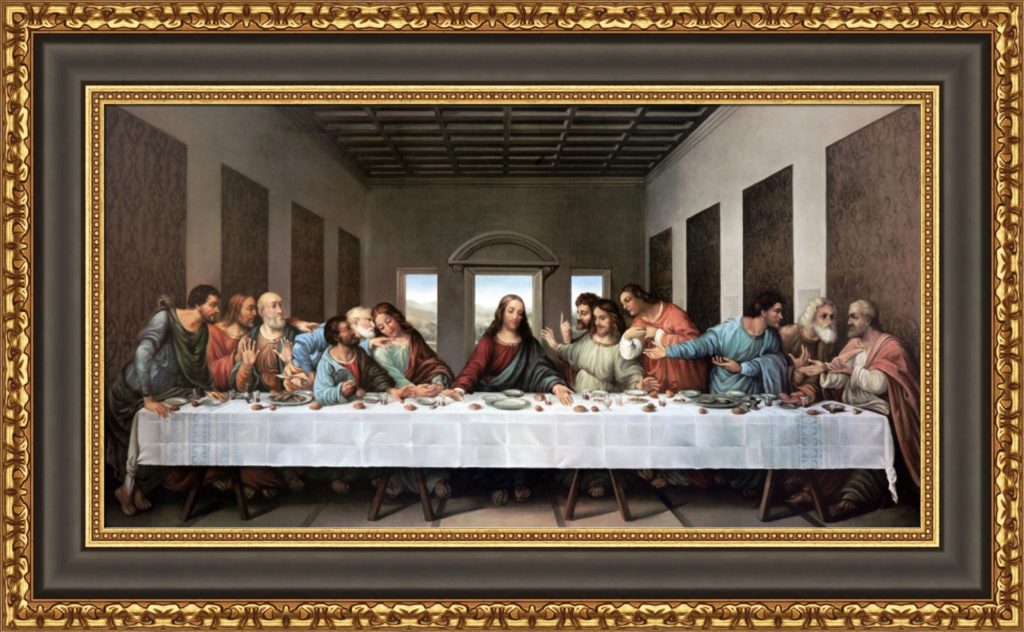
Everyone also pretty much listened to the same radio station as well. Each kitchen had this little plastic radio (of vintage electronic tubes) that was perpetually tuned to the AM radio station KDKA. Popular Music would often be heard while we were visiting.
Pop Songs
While I was pretty much listening to Jefro Tull, Traffic and other rock groups, my relatives and classmates enjoyed the popular music of the time. In 1971 we were listening to the following. Notable songs are highlighted in BOLD.
| Three Dog Night | Joy To The World |
| Rod Stewart | Maggie May / (Find A) Reason To Believe |
| Carole King | It’s Too Late / I Feel The Earth Move |
| Osmonds | One Bad Apple |
| Bee Gees | How Can You Mend A Broken Heart |
| Raiders | Indian Reservation |
| Donny Osmond | Go Away Little Girl |
| John Denver | Take Me Home, Country Roads |
| Temptations | Just My Imagination (Running Away With Me) |
| Dawn | Knock Three Times |
| Janis Joplin | Me And Bobby McGee |
| Al Green | Tired Of Being Alone |
| Honey Cone | Want Ads |
| Undisputed Truth | Smiling Faces Sometimes |
| Cornelius Brothers and Sister Rose | Treat Her Like A Lady |
| Rolling Stones | Brown Sugar |
| James Taylor | You’ve Got A Friend |
| Jean Knight | Mr. Big Stuff |
| Lee Michaels | Do You Know What I Mean |
| Joan Baez | The Night They Drove Old Dixie Down |
| Marvin Gaye | What’s Going On |
| Paul and Linda McCartney | Tom Jones |
| Bill Withers | Ain’t No Sunshine |
| Five Man Electrical Band | Signs |
| Tom Jones | She’s A Lady |
| Free Movement | I Found Someone Of My Own |
| Murray Head and The Trinidad Singers | Jesus Christ Superstar |
| Jerry Reed | Amos Moses |
| Grass Roots | Temptation Eyes |
| Carpenters | Superstar |
| George Harrison | My Sweet Lord / Isn’t It A Pity |
| Donny Osmond | Sweet And Innocent |
| Ocean | Put Your Hand In The Hand |
| Daddy Dewdrop | Chick-A-Boom (Don’t Ya Jes’ Love It) |
| Carpenters | For All We Know |
| Gordon Lightfoot | If You Could Read My Mind |
| Sammi Smith | Help Me Make It Through The Night |
| Carpenters | Rainy Days And Mondays |
| Cher | Gypsy, Tramps And Thieves |
| Jackson 5 | Never Can Say Goodbye |
| Lynn Anderson | Rose Garden |
| Hamilton, Joe Frank and Reynolds | Don’t Pull Your Love |
| Ringo Starr | It Don’t Come Easy |
| Nitty Gritty Dirt Band | Mr. Bojangles |
| Fuzz | I Love You For All Seasons |
| Dramatics | Whatcha See Is Whatcha Get |
| Carly Simon | That’s The Way I’ve Always Heard It Should Be |
| Stevie Wonder | If You Really Love Me |
| Aretha Franklin | Spanish Harlem |
| Helen Reddy | I Don’t Know How To Love Him |
| Osmonds | Yo-yo |
| Aretha Franklin | Bridge Over Troubled Water |
| Partridge Family | Doesn’t Somebody Want To Be Wanted |
| Tommy James | Draggin’ The Line |
| Ike and Tina Turner | Proud Mary |
| Chicago | Beginnings / Color My World |
| Bells | Stay Awhile |
| Stampeders | Sweet City Woman |
| Lobo | Me And You And A Dog Named Boo |
| Paul McCartney | Another Day / Oh Woman, Oh Why |
| Bread | If |
| Marvin Gaye | Mercy Mercy Me (The Ecology) |
| Brewer and Shipley | One Toke Over The Line |
| 8th Day | She’s Not Just Another Woman |
| Freda Payne | Bring The Boys Home |
| Rare Earth | I Just Want To Celebrate |
| Delaney and Bonnie and Friends | Never Ending Song Of Love |
| Freddy Hart | Easy Loving |
| Three Dog Night | Liar |
| Honey Cone | Stick-up |
| Mac and Katie Kissoon | Chirpy Chirpy Cheep Cheep |
| Andy Williams | Love Story (Where Do I Begin) |
| Cat Stevens | Wild World |
| Jerry Reed | When You’re Hot, You’re Hot |
| Beginning Of The End | Funky Nassau |
| Olivia Newton-John | If Not For You |
| King Floyd | Groove Me |
| Bobby Goldsboro | Watching Scotty Grow |
| Matthews’ Southern Comfort | Woodstock |
| Judy Collins | Amazing Grace |
| Dave Edmunds | I Hear You Knocking |
| Bee Gees | Lonely Days |
| Fortunes | Here Comes That Rainy Day Feeling Again |
| Who | Won’t Get Fooled Again |
| Denise Lasalle | Trapped By A Thing Called Love |
| Jackson 5 | Mama’s Pearl |
| Buoys | Timothy |
| Partridge Family | I Woke Up In Love This Morning |
| Isaac Hayes | Theme From “Shaft” |
| Gladys Knight and The Pips | If I Were Your Woman |
| Neil Diamond | I Am..I Said |
| Paul Stookey | Wedding Song (There Is Love) |
| Wilson Pickett | Don’t Knock My Love, Pt. 1 |
| Doors | Love Her Madly |
| Richie Havens | Here Comes The Sun |
| Wadsworth Mansion | Sweet Mary |
| Brenda and The Tabulations | Right On The Tip Of My Tongue |
| Fifth Dimension | One Less Bell To Answer |
| Doors | Riders On The Storm |
| Perry Como | It’s Impossible |
The song “Maggie May” was played to death, and radio stations in central Indiana were still playing that song long into the 1990’s. Ugh!
Donny Osmond was terribly popular with my sister and all of her girl friends at the time. Her bedroom was covered in pictures of Donny, and she had her class room textbooks covered in “lunch paper” covers decorated with Donny Osmond related praises.
I first heard “The night they drove ol’ Dixie down” when I was riding with my dad in our car. He was involved in technical sales at the time. I would wait in the car and listen to the radio while reading the “Last Whole Earth Catalog“.

Tom Jones was very popular with my mother and the mothers of my friends. He had a kind of sex appeal that really appealed to them.
Jesus Christ Superstar hit my generation hard. I cannot express how big an impact this movie made at my church and at my school. It seemed like every family had the album. I went and saw the play and it was really moving.
I saw Jerry Reed sing “Amos Moses” on “Laugh In” or “Sonny and Cher” I don’t remember which. Both were shows that hosted a mixture of singing, dancing and comedy routines that were quite popular in the day.
The song “Gypsy, Tramps And Thieves” was a big hit by Cher. Most people have forgotten about her today. You hear some blurb on the news every now and then, but she was a big thing back in the day. She was super popular.
The song “Don’t Pull Your Love” was very popular and got a substantial amount of airtime. You probably couldn’t get by a day without hearing that song at least once. Other heavily air-played songs included “Mr. Bojangles“.
Everyone in my school watched the Partridge Family . This was a television show about a family that toured schools all over the country and sang at them. Well, they also had a number of hits, as well as a had a following of fans.
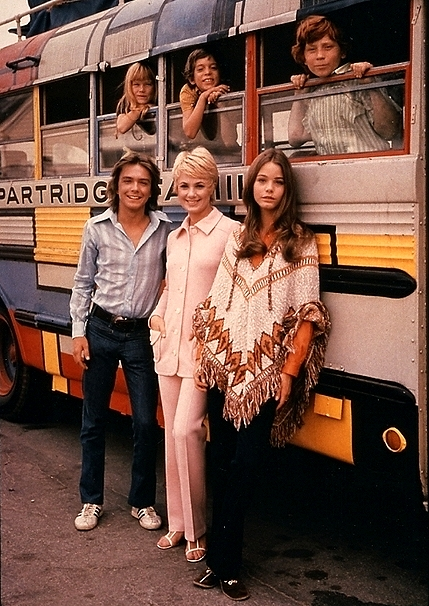
The idea and concept of freedom to explore, of adventure and travel was very popular. The ideals of the 1960’s were fading away, and the 1970’s was a time where people wanted to just go forth and explore the world. The song “Me And You And A Dog Named Boo” was representative of this dream.
If there is one iconic song from that year (heck, for that decade), it is “One Toke Over The Line“. Everyone was listening to it, and everyone related to it. Even my mother who would make the “sigh” and gesture while saying “I guess I’m just one toke over the line…”.
This song “Never Ending Song Of Love” has fallen into obscurity. Yet it reflected the reality of the small town bars and the culture of friendship and love that was indicative of the era.
The song “Riders On The Storm” continued to be popular with me and my classmates long into our college years.
Barbershop
Next to my Father’s parents house was a barbershop. The shop was run by an old man, probably in his 90’s. He lived upstairs above the shop. The barbershop itself was a museum and probably hadn’t changed since the 1940’s.
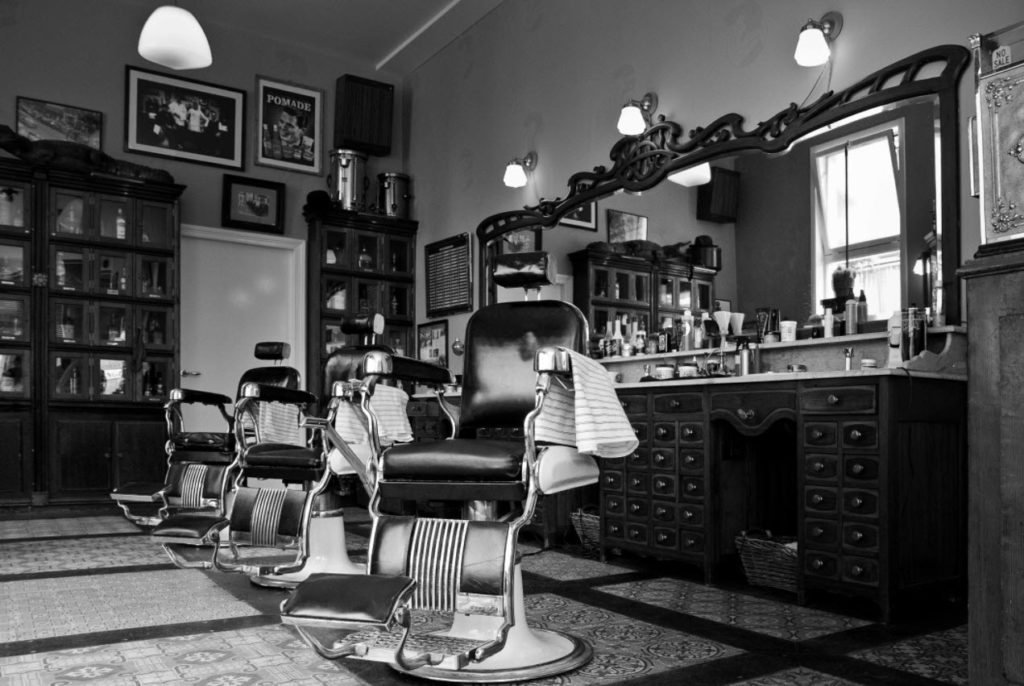
My father would take me to the barber there and I would get a haircut. I really didn’t want to go because at that time, long hair was fashionable. I would go there and then pout the rest of the day. But, I’ll tell you what, those trips to the barbershop were some of the best memories that I have.
The barbershop was a “men’s only” establishment. On the tables were magazines about hunting, guns and adventure. On the walls were pictures of deer and ducks. There was a full length mirror on the wall that faced two very huge and ornate barber chairs. The barber wore an apron and wore his hair in a style that probably went obsolete in the 1950’s.
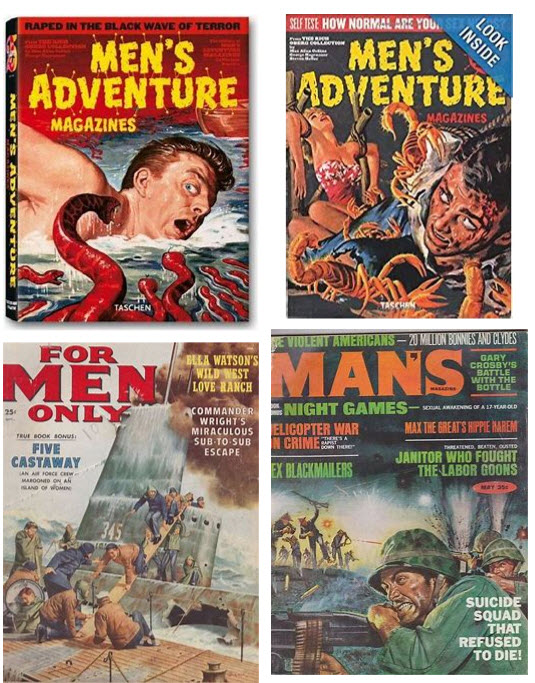
The chairs were big and comfortable. He would often have friends hang out while he worked. They would sit there smoking cigarettes and watching him cut hair. A small radio would be on and often it would be tuned to a baseball or football game.
The place had it’s own kind of unique smell to it. It was a cross between aftershave and and old house. The barber lived alone as his wife passed on a decade earlier. He just ran the shop until he died. After he passed on, the place was boarded up and then demolished.
Hiking in the Woods
At that time in my life I spent a lot of time hiking in the woods. I would often ride my bike all over town and up and down the back roads and railroad spur lines. In the Spring the air would be fresh with the smells of lush forest canopy. In the Fall, it would be a time of warm “Indian Summers” with red and yellow leaves that would blow in the light breezes.
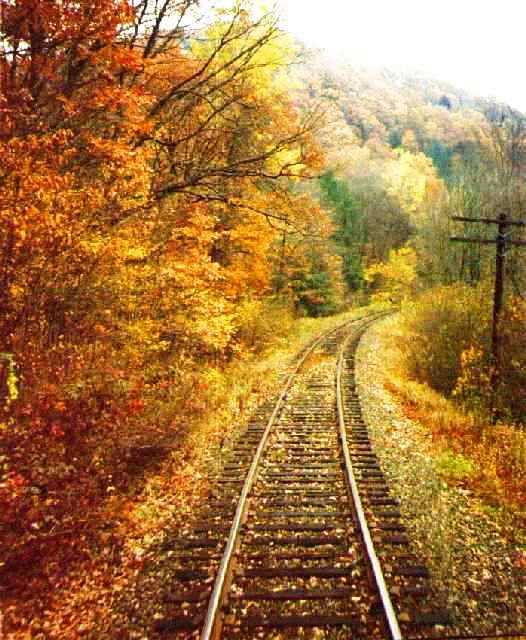
I rode a gold Schwinn “banana seat” bike with “high bars” and a “drag strip” (non-tread) rear tire. Every one of my friends owned a bicycle. My sister had one with a white plastic basket in the front. My bike had these long streamers of plastic that plugged into the handles. I eventually tore those things off. But I would put a card (from a deck of cards) and attach it to the bicycle with a wooden clothes pin. That way my bicycle would make some “cool” sounds when I rode fast. It had a huge red circular red reflector on the back, right under the white “banana seat”. Like the GTO I would later drive when I was in High School, the bicycle was an orange color.
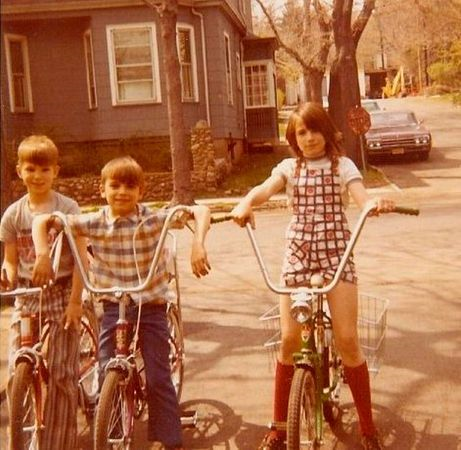
My bike was a personal selection. When my father took me to a store to pick it out, I chose a really simple and rugged model. There were no front or rear brakes on the handlebars. To brake, you would just use the pedals. There also weren’t any gears. There was one gear only. It came with a rear view mirror, that soon broke off, and that was about it. My friends all had more complicated bicycles, and over the years, they were perpetually repairing their bikes and trying to fix them. For me, I never had that problem.
Television Shows
At that time the only television channels that we could watch were CBS, NBC, and ABC. We also had “channel 13” which was a government channel. All of our news, and our entertainment came from these three sources. Since we never had the kind of selection that we have today, we didn’t find anything wrong with it. It was normal for us.

As sparse as the selection was, we were perpetually glued to the television set. There was usually a movie a night. They were often a few years old, after being shown in the movie theaters. If the movie wasn’t shown in the theaters it would be called a “World Premiere Movie”.
Television was rather primitive.
While we did have a color television, we still needed to walk across the room to change the channel. Imagine that! Remote controls were not available until the mid-1970’s. On top of it were “rabbit ears” until we were able to subscribe to cable in the late 1970’s. My grandmother had her “rabbit ears” with aluminum foil wrapped around it. She said that it improved her reception. Maybe it did. I don’t know, her reception really sucked, so it must have been really, really terrible.
My favorite after-school show was “The Flintstones”. All of my classmates watched it. There were many shows that I watched when I was growing up. It went from the black and white “Diver Dan” series, to the Fireball XL-5, Supercar, and included such staples as Gilligans Island, and the Man from U.N.C.L.E..
I would watch the news reluctantly. For me it was pretty boring.
However, I did follow the news about space. You couldn’t miss it. Everyone was talking about space, and the moon. That is all you heard about as a child of the 1960’s. The television shows also helped to maintain this theme.
As the news that played on the radio concerned our exploration of space and the Vietnam War. Of course I didn’t know what was going on. It was a takeover of the United States government by dark forces embedded deep inside the United States government. When JFK was shot, my father insisted that I watch the television. He kept telling me that this was the most important thing to happen to the United States since the Civil War. He was a lifelong Democrat and he had real concerns that there was more to the story than what the government was saying. Later, after he died and President Trump released the transcripts, it turned out that my father was right after all.
The “Deep State” murdered our President.
“This fucker, johnson should be dug up and pissed on, and torn apart. Every modern ill can be traced to him.” -sowhat1929
On Sunday we watched Mutual of Omaha’s “Wild Kingdom”, and “The FBI” (Starring Efrem Zimbalist Jr) after the Walt Disney hour. If I wasn’t watching television, I was building plastic scale models, or experimenting on my Gilbert chemistry (and electrical) sets.
The A. C. Gilbert Company was an American toy company, once one of the largest toy companies in the world. It is best known for introducing the Erector Set to the marketplace. A chemistry set is an educational toy allowing the user (typically a teenager) to perform simple chemistry experiments. During the Bill Clinton presidency (D) all sales of chemistry, electronics, and mechanical kits were put under investigation as possible routes for “home grown” terroristic activities, and were subsequently suppressed, if not outright banned. Over the Bush years (R), they resurfaced and eked out a small living. However, by 2017 most hobby kit suppliers went out of business. Ramsey electronics, Heithkit electronics RIP.
At that time in my life, I like the rest of my classmates, watched shows like the Partridge Family and The Brady Bunch. These shows were about “us”. It was how we interacted with each other, and our families and our communities. This all began to change when the television media decided to change their programming towards minorities in urban areas. Television began a slow phase away from white families living in suburbia and began to concentrate on poor urban minorities.
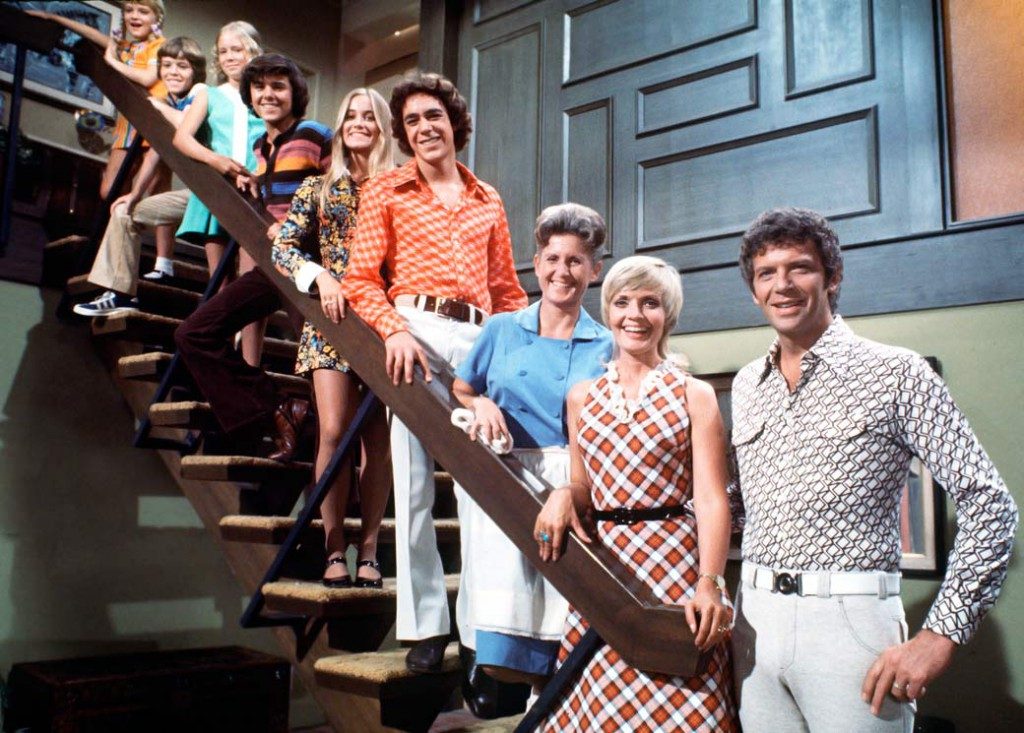
Shows about black people were limited to “Stanford and Son”, and “The Jefferson’s”.
“The "rural purge" of American television networks (in particular CBS) was a series of cancellations in the early 1970s of still-popular rural-themed shows with demographically skewed audiences, the majority of which occurred at the end of the 1970–71 television season. In addition to rural themed shows, the purge also eliminated several high rating variety shows that had been on CBS since their beginning of television broadcasting. One of the earliest efforts at channel drift, CBS in particular saw a dramatic change in direction with the shift, moving away from shows with rural themes and toward ones with supposedly more appeal to urban audiences.” -Wikipedia
The shows we watched were funnier than what you see on television today. And, maybe, just maybe a little more innocent. “The Bob Newhart Show” was typical. The humor involved day to day situations and NEVER mentioned race (compare that to today), and had a real twisted surrealistic sense of humor. Consider “Mary Hartman. Mary Hartman”, or “Green Acres”. You can find out more here.
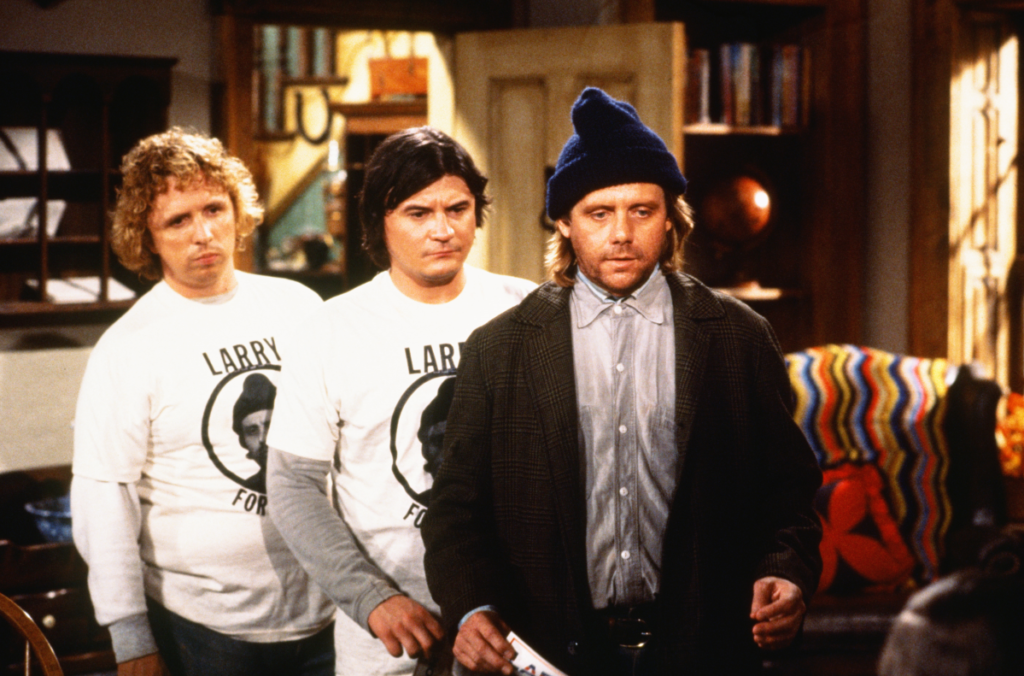
Ah, you’ve got to hear about the three yokel brothers in the (very surrealistic) 80’s “The Bob Newhart show”. I loved these guys. They might have been the highlight of the show. Heck, they could have had their own show (hint. Hint.)
“…discovering that a witch is buried in the basement of their Vermont inn. They want to find out who she was, but they also want her 300-year-old grave dug up and removed. The silly-from-next-door tells him he knows some guys who`ll do anything for a buck. Next thing, three goofy-looking, backwoods brothers from the genetically weak side of Vermont show up. “Oh, Lord!” says Bob, getting a whiff. Larry--the only brother who ever talks--hands Bob their card. “We`ll do anything for a buck,” it says.” - Larry, Darryl And Darryl Are `Newhart` Hits
Larry was the spokesman. Darryl and Darryl never spoke except in the classic final episode. No matter how many times Larry met you, he always started off by saying “Hello. I’m Larry. This is my brother Darryl and this is my other brother Darryl.”
They were quite good hearted, and obviously lived a strange, strange life. Afterall, clubbed weasel was their idea of good eatin’. Larry’s totally deadpan delivery of some very bizarre lines was always a highlight of any Newhart episode. “We went to the bakery ’cause they were advertising ‘bear claws’, but it turned out to just be a come-on.”
Ah. Good times. Good times.
Movies and television portrayed westerns (with “white men” taming the wilderness), war adventures (mostly involving world war II fighting the evil Nazi army), space exploration (such as Lost in Space, Star Trek, Fireball XL-5, Thunderbirds are Go and Land of the Giants), and Spy Adventures (against the Soviet Union or against fictional organizations such as T.H.R.U.S.H.).
Scale Models
One of my favorite hobbies was the building of plastic models. These were often of ships, airplanes and military hardware. I made a few models of cars, but my favorites were of military tanks and figurines.
I had a desk in my bedroom. It was an old desk inherited from my father with four drawers. I used a fold-up “card table” chair to sit at it with. On it was a 1940’s style desk lamp that my parents must have pulled out of the garbage at some time. I had books on the desk, a “multiband” radio where I could listen to FM radio, and a pencil holder made out of a decorated metal coffee cup tin.
At that desk, I would assemble, build and paint my models. It was an enjoyable pursuit. The desk faced the window in the bedroom, and I would often have the windows open, but the shade drawn down about half way. The shades were in the old 1960’s style and were meant to last. They had this kind of “life preserver” style ring hanging on a string that you could pull down to raise or lower the shade.
I needed the fresh air, as the odor from the glue was toxic and would tend to get me all flustered when I used it. I remember once, that my sister was watching her television show and they were really pushing the Rigley Chewing Gum-gum-gum… Rigley chewing gum-gum-gum commercial. It must have been running every ten minutes. I was about going out of my mind with the combination of the toxic glue odor and the subliminal programming of the chewing gum. Ugh!
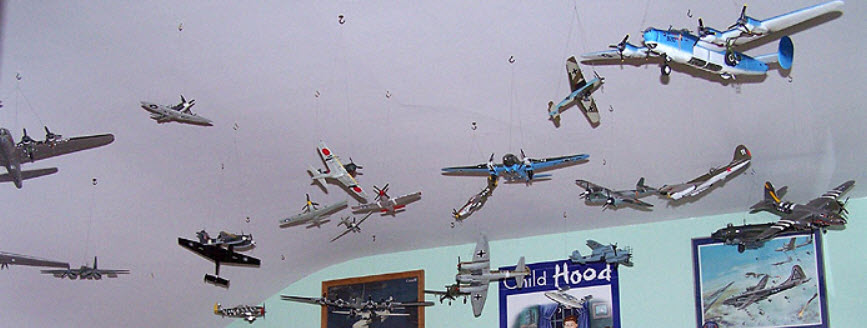
The airplanes I would hang from the ceiling with string. I would display my collection of tanks and military equipment on shelves alongside my collection of centuries-old bottles. (I was an avoid junk collector and was always on the lookout for discarded bottles that I would collect from ancient trash dumps in the nearby forests.)
I collected Tamiya 1/35 scale military hardware models. I had quite a collection of German vehicles and tanks. At that time, the Japanese model maker Tamiya made the best quality models. They had an innovative introduction process that added new model to the collection every few months.
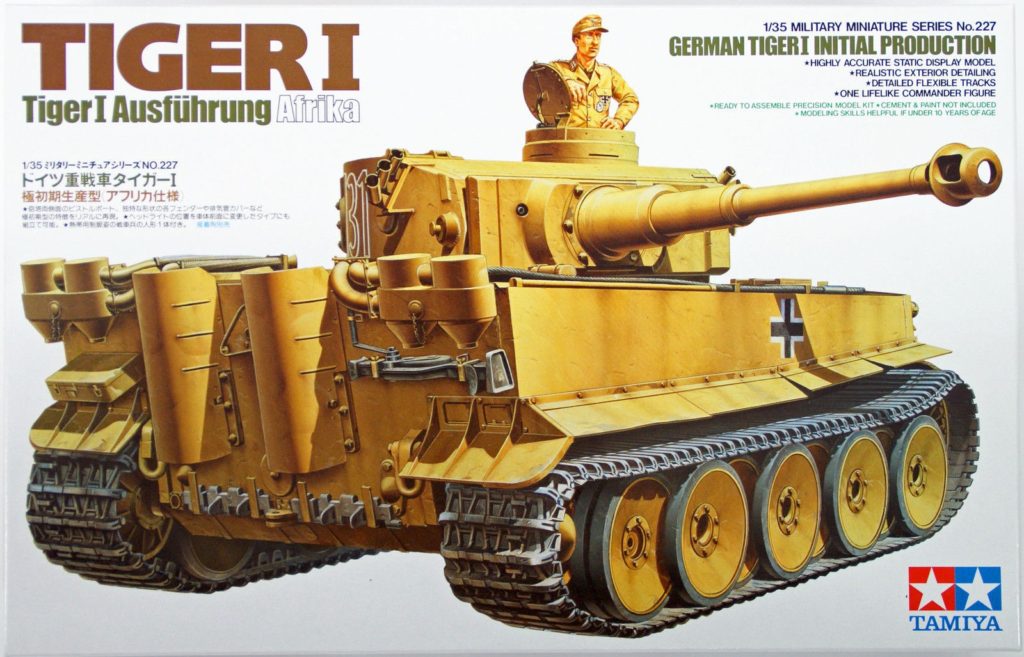
Alas, when I graduated from university I discovered that my mother had thrown away all of my models. She didn’t want all the clutter in the house. I guess one person’s treasure is another person’s trash.
Science Fiction
I started reading Science Fiction avidly. With one of the first books being the “Mad Scientist Club”.
The Mad Scientist Club is a series of stories (and books) written in the 1960’s which fueled the imagination and adventures of us children in the 1970’s. (The son of the author has a website. You can visit the website HERE.) These stories inspired me. They inspired my dreams and led me down the path towards technical excellence.
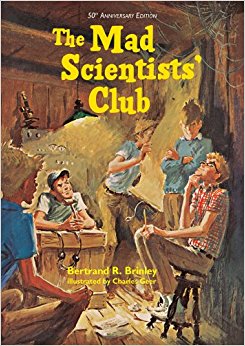
The boys in the stories used science to create all sorts of pandemonium and mayhem in their little town. They applied themselves to using science to make devices and gadgets. They played pranks. The books showed how a boy could engineer a device from techniques that they learned in school. They made balloons, talked on ham radios, devised electronics, and they did it all on their very own.
The beauty about all this was that they never asked for help or permission. They took the initiative and did it on their own. They applied themselves.
Indeed, these stories are special. But, don’t take it from me. Read what others have to say.
“This is the best kids book ever. … In a way it saddens me when I re-read it. I don't think our kids today have as much freedom as these did (or my generation). I remember staying out until dark, riding my bike EVERYWHERE, clubhouses on vacant lots...Or maybe it's responsibility. Kids today have freedom but little responsibility. I'm getting off my soapbox now. but this is a cool book and it will make your kids fall in love with science. I imagine the Mythbusters grew up like this- or maybe their dads did!! ” -Holly commentary on the book. Found at Goodreads.
I am afraid that Holly is correct. American children (and adults) don’t have as much freedom as we all used to. (It’s our fault, you know.) These books are for kids and inspires them to accomplish things through study and action. These books are not about getting a group together and finding a group consensus. It’s not about how to cautiously speak so as not to offend anyone. Nope. It is about getting things done and raising hell in the process.
It’s books like these that inspired many of us to study science and engineering. It certainly affected me. It also affected others. I am not the only one who studied about rockets and space…
“This was simply a great childhood book for any inquisitive kid who likes science, haunted houses, dinosaurs, flying machines, etc. I read this book in about seventh or eighth grade and actually a couple of times since. I believe this book helped me on my career to being a rocket scientist but it also gave me many ideas as I was growing up. Brinley managed to capture the perfect mid-west US town and the guys in the book were great caricatures of fun loving, science minded boys with a bit of good natured mischief up their sleeves. Then Brinley took this setting and boys and produced a series of wonderful stories capturing so many things that so many boys growing up find so intriguing. I bought a copy recently for a nephew and he was enraptured by it. The follow-ups while good never really reached the level of this first book but were fun in their own right. It will always hold a special memory of growing up back in the '60s.” -Robert commentary on the book. Found at Goodreads.
He’s right you know. The stories certainly inspired me.
I like to think that there is inspiration in stories where you find adventure, freedom and independence. These are things that are absolutely missing in the modern realm of politically correct stories. Which, by the way, is a very important point. By following a “Politically Correct” narrative, you retard the growthof young boys. To paraphrase Clint Eastwood, you turn men into pussies.
“We live in more of a pussy generation now, where everybody's become used to saying, "Well, how do we handle it psychologically?" In those days, you just punched the bully back and duked it out. Even if the guy was older and could push you around, at least you were respected for fighting back, and you'd be left alone from then on.” -Clint Eastwood
A parent has a responsibly to PREPARE their children to venture out and grow. They need to go forth and carve a life out of the wilderness. But that is not what is happening today. Instead we have children that never leave the nest. Young men, in the United States, live at home until they are in their 30’s. Instead of investing their time in building, workings, making, and creating, they are too busy looking at cat videos on the Internet while they post their latest latté on Facebook. Boys must be taught to aspire to be Men, not to be a woman’s version of a sensitive man.
Pussies.
No amount of tattoos, unique hair or beard, or cool urban clothing style is going to make you into a Man. It comes from within. Education alone won’t do it. Money and wealth won’t do it. Polite conversation won’t do it. It comes from inside. It comes from deep down inside. It comes from a place that says “you can, and must do what you need to do”. You don’t ask for permission, or consensus. You go out and carve your life out. Alone.
By clutching on to your children like over protective mothers, the children don’t grow up. Physically they might age, but the brain and the emotions are still that of a young child. How else can you explain the SWJ mentality that demands a protective overseer? Which is what they want, you know. They demand to be coddled and taken care of by a big parental government Bernie Sanders style. Because, that is all that they know. They don’t know how to be independent. We don’t teach that anymore.
These books break us out of that mold…
“A gem. Almost unknown; but one of the most hilarious and memorable laugh-out-loud books you could ask for. It's never mentioned by anyone; it's never recommended, placed on book lists or chosen by reading-groups. This just might be because it's a series of books, which represents a 'philosophy-of-parenting’, which has fallen out of favor. That's my suspicion, anyway.
I mean, just think about it. These stories are about kids who are unmonitored; who are allowed to just go off on summer afternoons and hang out on their own; and do whatever they want.... because they are trusted by their folks. Today, this is the last thing parents want to hear. No one in today's control-freak, micro-managing America wants to imagine that children can be trusted like this.
Books for very young children ('Little Prince' or 'Giving Tree') are in abundance on Goodreads. They're sweet and harmless. There's also a new genre called 'YA' ('young adult'). But guess what? They're all very sanitary, careful, cautious, and timid. Antiseptic. Content-supervised and Content-controlled. They always instruct youngsters on the 'correct' thing to do, the 'sensitive' thing to do, the 'courteous' thing to do...blah blah blah.
'Mad Scientists' is different. Instead of caution, the author praises problem-solving, solidarity, daring, and initiative. It's a book written for kids illustrating how NOT to follow the rules. It’s a book, which shows that rules are made to be flouted.
These stories are from a time when today's endless complexities and anxieties just weren't around. It’s a book that deals with kids just... having fun. I say, there need to be a LOT MORE books like this.
The gang of boys in Brinley's tales are pre-teens; somewhere between 11 and 14. This is a strange interval in a boy's matriculation, when they need to figure out a lot of things about life (and it’s also a time when adults have the least relevant advice to offer). This is the space Brinley plays in: the theme of personal responsibility.
Teens NEED to create a few genuine catastrophes in order to learn the weight of 'cause' vs 'effect'. 'Intention' vs 'outcome'. 'Actions' vs 'harm'. They need to learn the ins-and-outs of friendship and loyalty and paying-one's-dues.
The 'Mad Scientists Club' (this is the name carved on their clubhouse door) demonstrate these themes grandly. These young scamps are precisely in that age where you learn how to make a mess and how you clean it up afterwards. By yourself!
The crazy scenarios which afflict these affable 'troublemakers' reminds us--should remind everyone-- that this process can be fun. Making mistakes and learning from them. The best way --nay, the ONLY way--to shape character.
Far cry from today, huh? Yeah. Today, we don't let kids have 'secret clubs', 'hideouts', codewords, or 'mysterious friends'. We don't let them play with equipment or tools. They must not 'wreck' anything of ours. They're certainly not allowed to 'gallivant all over creation' (love that phrase).
Modern parents are rule-mongers and control freaks. When our kids want to play, we take them to 'Sesame Place' and we monitor their nutrition and we deck them in flashing sneakers and put them in helmets and on leashes. We place them in soccer, swim class, softball, karate, dance, gymnastics.
The result? Modern kids have no idea what real 'freedom' means. We never give it to them. They turn out to be vegetables.
But Brinley's kids show the other way it can be done. This boy's club makes their own fun. They don't 'ask for permission' to do stuff--they just do it! They embrace wildness, zaniness, and unpredictability. The outcome? Well, they aren't brought up on charges from the Department of Homeland Security, for the trouble they cause. That's for sure. This is a part of small town-Americana we've let slip away.
Just one example: in one of the adventures undertaken by the Mad Scientists, they build their own hot-air balloon (using scraps from a local junkyard) and they enter it in the town's annual homemade hot-air balloon race. With no adult supervision at all. Once aloft, (!!) they engaged in an air-battle with their arch-foes and fire potato-cannons and slingshots back'n'forth in mid-air. Finally, they manage to send the enemy gang's balloon into the lake! Can you stand it? I can't friggin' stand it, can you?
This book reminds us that children used to be perfectly capable of taking care of themselves if we let them...if we weren't all scared out of our wits by molesters and semi-automatic weapons and drugs and porn and stalkers and computers, we'd still remember the kind of America found in this hilarious read. It's to our shame that we can't.”
-Feliks commentary on the book. Found at Goodreads.
Let me simply posit this; to all those men (not to intentionally exclude women, but I am a man addressing myself to other men) who have made something of their life. Maybe you are a barber, a motorcycle mechanic, a car salesman, or a cook, isn’t it true? To make it in this world, you need to stretch your neck out. You need to take risks, bend the rules a little. You need to apply yourself.
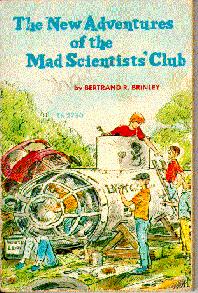
Those times when life got tough, did you go and get permission? Did you go and ask for consensus? Did you politely ask for others opinions, or did you just go out and do whatever it took to achieve your goals? Was it easy? Nope, I’ll wager that it was hard, or at least uncomfortable. You might have to make sacrifices. Right? Right???
Part of the need to accomplish these tasks were goals. These goals were like this golden orb that lay there, just out of reach that you needed to obtain. You would work towards those goals. You would keep those goals in mind while you fought and persevered. A goal might be a car. A goal might be the love of your life.
A man is nothing without a goal.
A goal might be something more honorable and important, like saving the world. As everyone can’t be an evil villain like George Soros. Or, a wealthy trillionaire like Bill Gates. Someone needs to wear the mask of a hero…
The Idols
My bedroom was decorated as any boy of my my age would have. It was festooned with models and collections of brick-a-bract and posters on the wall. I had a poster of Farah Faucett on my wall. She was smiling with this amazing smile, and her huge hair. We all had a crush on her. That as well as Loni Anderson and Rachael Welch . Look at her!
How can you not smile?
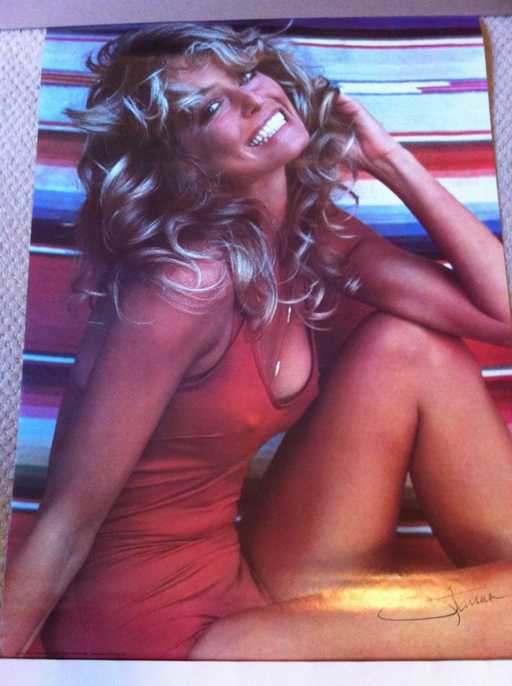
I had numerous posters on my wall. One was the mandatory “black light” poster on velvet. (It glowed under UV light.) One was a picture of Richie Blackmore (Deep Purple) performing a guitar solo. (I had super imposed a F-14 on it for combined imagery. After all, space and high-performance aircraft and rock n’ roll was my dream.) One was a Roger Dean poster (anyone remember the group “Yes”?).
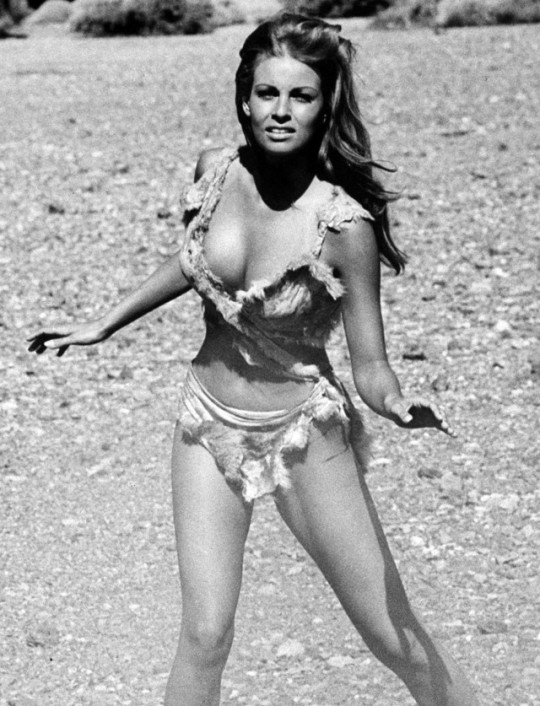
I became a fan of Loni Anderson in her role in the television sitcom “WKRP in Cincinnati”. I think many of my friends did as well. We loved her and watching her on the show was always a highlight. That and the clueless manager who ran the office.
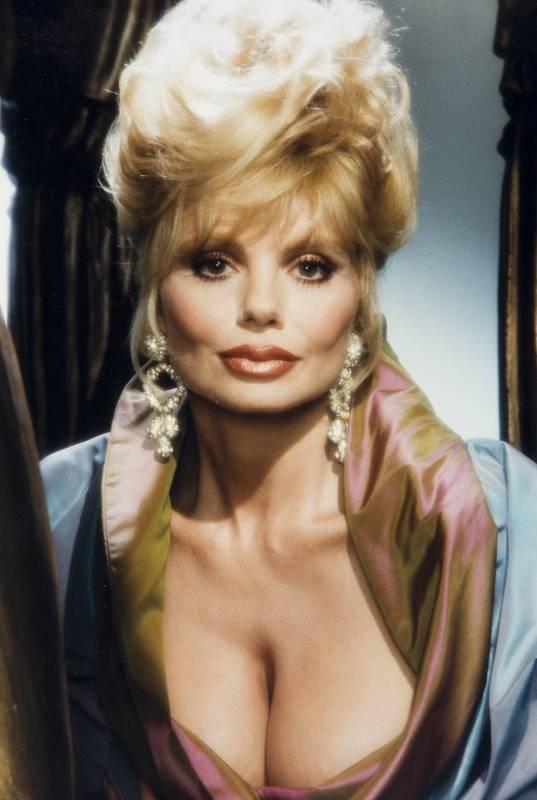
Telephones
There were no cell phones; indeed most phones hung on the wall, and fully 50% of them had dials instead of push buttons. Our home had two phones. One was an old Bakelite black phone from the 1920’s hidden away in the basement. I loved the feeling of it. There was a weight to it that you just couldn’t get during the 1970’s. We also had a “main” phone in the kitchen. It had an extra-long cord. My sister was always “hogging it up”. So one year they bought her a phone for her room. She still spent most of her time on the phone, it’s just that she wasn’t talking in the kitchen all day.
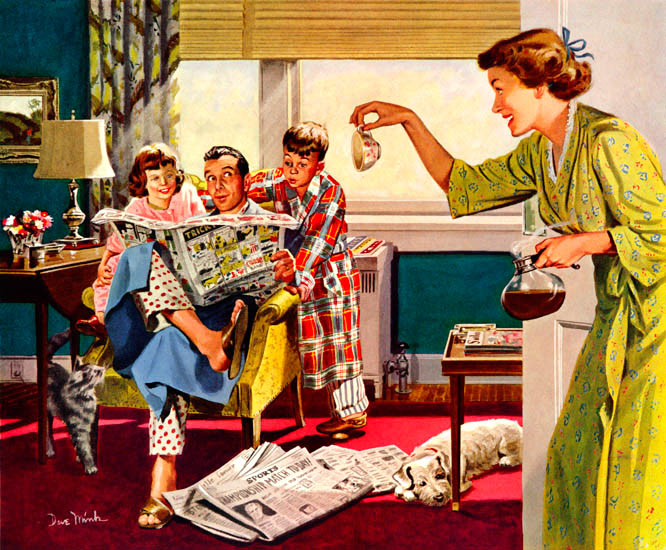
In the house we wore “house clothes” also known as PJ’s, with a robe. Mother would make sure that there was always a pot of coffee brewing, and us kids would always fight over who would get to read the comics section of the paper first. Of course, our dogs and cats merrily participated in the morning ritual. Picture above is not the ideal, it was the actual.
Global Cooling and the “Green Movement”
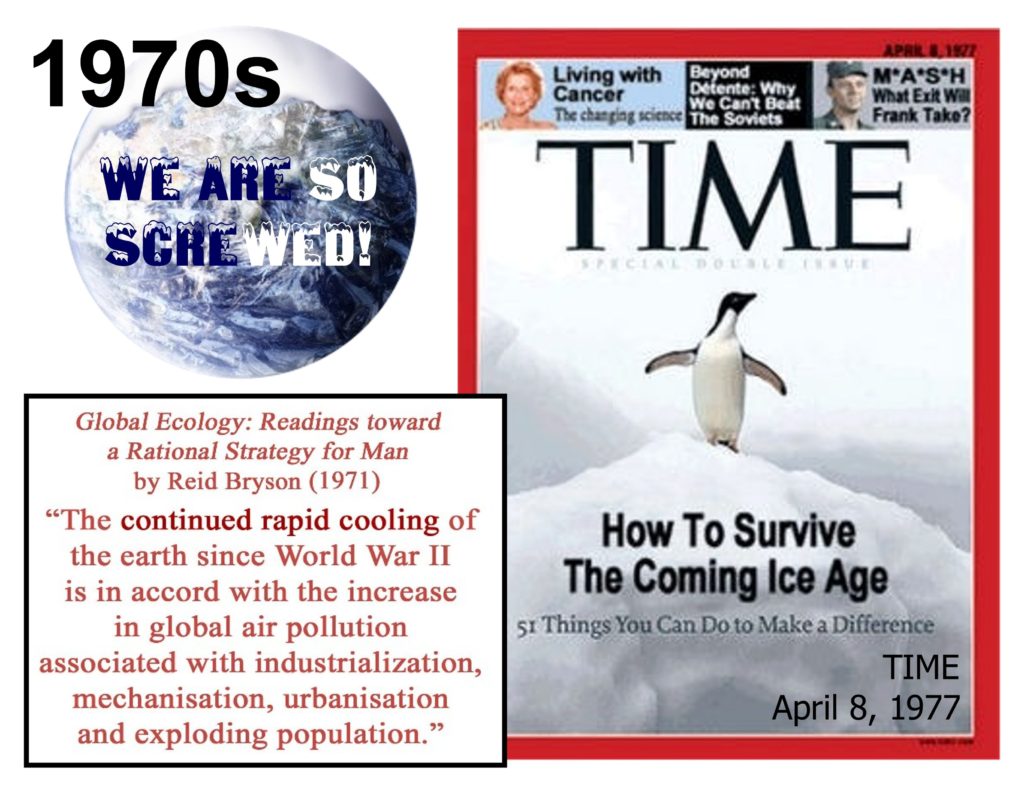
In our schools we would go on field trips to clean up the environment. We would go on “collection drives” to collect money for our environment, and we ended up with absolute bushels of money. (Don’t know where it all went, though…) We attended classes on the environment and school rallies to lecture us on the up-coming global cooling that would soon turn the world into a snow cone.
We were terrified!
Every cold day was a sign that the world was plunging into another great ice age. Magazines, the media, and the news all had stories about the coming cold period and the need to raise taxes to save our environment. Experts were paraded on television to teach us the need to raise taxes, and fund more research.
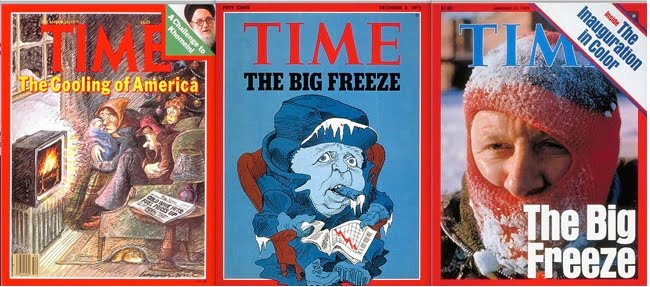
The “Love Canal” fiasco acted as a terrible “kick start” to the “environmental movement”. Americans began to wake up that we had been really abusing our environment. As such, immediate action had to be taken. And thus the government took action in the only way that it knew how…
- It set up the EPA, and…
- Raised taxes.
Which was the entire purpose of the decade long propaganda push; To [1] increase the size and scope of the government, and [2] to raise more taxes to go to Washington D.C..
“What’s it mean, anyway? Do 97% of #Scientists agree that the climate is changing? Actually, everyone agrees with that – that the Earth’s climate changes over time is why we had an ice age. Well, we had an ice age a long time ago. We did not have one after the #Science people promised an ice age in the 1970s. But shhhh! We’re not supposed to mention that.
Want to know what the proposed solution for the ’70s ice age that never arrived was? Give the liberal elite more money and power. Overpopulation was another big crisis in the ’70s too. It never arrived either. The solution to that was to give the liberal elite more money and power. And when they were warning us about acid rain destroying us in the ’80s? The solution to that crisis was also to give the liberal elite more money and power. The ozone hole? Yep, more of our money and power to the liberal elite. Back in the 1990s, the Al Gores of the world were warning us that we had just 10 years left to save the Earth unless … wait for it … we gave the liberal elite more money and power.
Sense some themes?
Each of these crises all had two things in common. Thing One was that none of these doomsdays ever produced the promised doom. Thing Two was that each was a demand to give the liberal elite more money and power.”
Family Meals
One of the things that I have come to appreciate the most was the family meal that we had when I was growing up as a child. During my early childhood we would hold formal “sit down” meals in the Dining Room. Us children each had our own roles / chores in regards to this. On Sunday we would have the largest and most elaborate meals. Mealtime was the opportunity when we could all talk about our day, our hopes and dreams, and things that interested us.
At the time, I didn’t realize how important it was.
Then, during the 1970’s everything changed. Both of my parents had to work. (You can thank the American Federal Reserve for the decline in the value of the dollar that necessitated the breakup of our families.) A formal family meal was replaced with “help yourself” fix your own meals, out of a pot on the stove, or “make yourself a snack” out of the refrigerator. We would then scrounge something up, and eat it alone watching television.
Communication was via notes on the refrigerator.
Now that I am much older, I can see clearly the value of a family meal as well as a community meal. As such, I now dictatorially enforce an observance of this tradition within my own home.
Fishing with my Father
I will conclude with this little narrative of my experiences in 1971 talking about my father. He used to spend the time and take me and my siblings out to the river to fish. He had a couple of rods and a tackle box that he inherited from his (favorite) uncle. Using it, he taught me how to fish, and how to gut and clean the fish.
While it is a great memory of mine, the best part, and the part that remember most clearly is how he would drive out to the lake or stream, and we would then troop down to the area to fish. He was always on the lookout for isolated and secluded areas to fish in. He yearned for the “perfect spot”. One with deep water and plenty of overhanging limbs and trees that fish can hide in.
Oh, I would go fishing with my friends. They had an assortment of remote cabins, canoes and secret places that always provided us a great deal of pleasure. But, it was the times with my father that mattered the most to me. My friends were always up to something.
I once had a friend who placed plastic sheeting on his garage floor and dumped a dump truck full of soil on it. He, at age 13, had constructed a worm farm, and he somehow had this crazy idea that he would get “filthy rich” selling worms to the local bait and tackle shops. He did actually manage to sell some. I think he might have made $5 or so. Eventually, he gave up the idea and paid some one to haul the dirt away. His dream of instant millions went bust.
I never became an expert at fishing. I was, I guess you could say, an enthusiastic hobbyist. For me, the time with my father fishing were some of the best moments of my life, and moments that I will treasure until I too, will die.
Conclusion
This was just a little narrative that I wrote about what it was like for me in 1971. It’s a far cry from the United States today. The USA today saddens me. Every time I read the news, I get either depressed or angered. There’s not really too much that I can do about the slide into open civil strife that America is plunging towards, all that I can do is take care of myself and think good thoughts.
This includes what it was like growing up as a boy.
Take Aways
- Global Cooling was a sham designed to trick Americans into permitting a larger government and giving away more of their money.
- There were only four television channels that we American had access to in the early 1970’s.
- The family meal is the most important part of having a family. It is important to nurture and cultivate relationships.
- Television shows used to focus on American culture instead of bastardized urban minority culture.
- My favorite memories of my father was when we were fishing together.
-
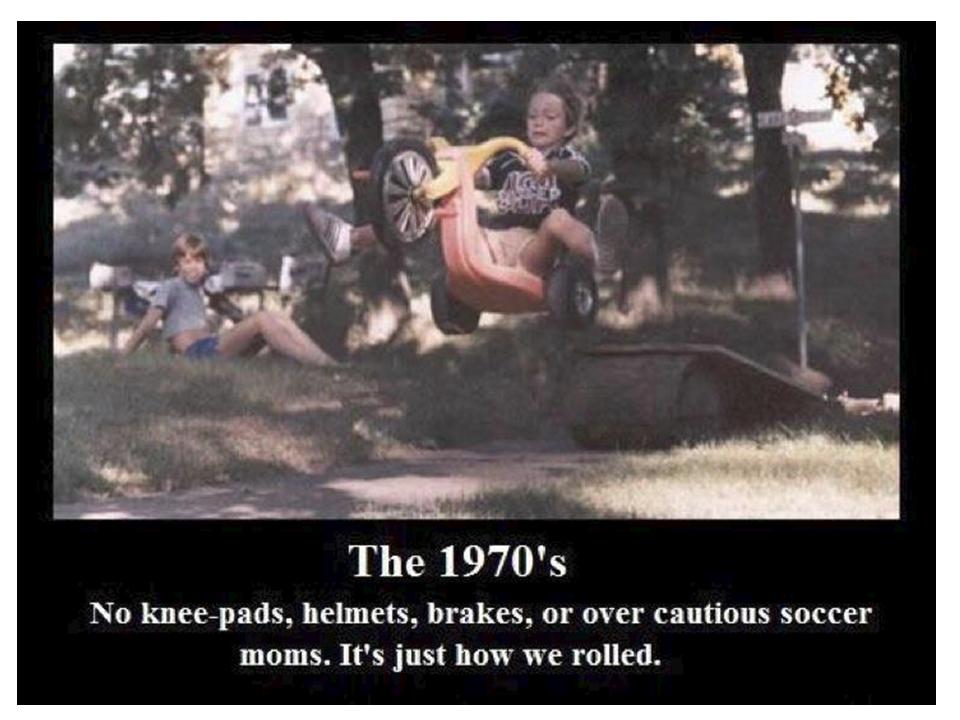
This is how we rolled. We were allowed to experience life in all it’s ugly and beautiful glory. Life is about living.
Posted On Free Republic
This article was posted on Free Republic in the chat section and collected a number of interesting comments. Many of which, I really do need to write about. Particularly what it was like for my sisters at that time, the cars that we drove, and the cultural things going on in society at that time. You can read the comments HERE.
Posts Regarding Life and Contentment
Here are some other similar posts on this venue. If you enjoyed this post, you might like these posts as well. These posts tend to discuss growing up in America. Often, I like to compare my life in America with the society within communist China. As there are some really stark differences between the two.
More Posts about Life
I have broken apart some other posts. They can best be classified about ones actions as they contribute to happiness and life. They are a little different, in subtle ways.
Stories that Inspired Me
Here are reprints in full text of stories that inspired me, but that are nearly impossible to find in China. I place them here as sort of a personal library that I can use for inspiration. The reader is welcome to come and enjoy a read or two as well.
Articles & Links
- You can start reading the articles by going HERE.
- You can visit the Index Page HERE to explore by article subject.
- You can also ask the author some questions. You can go HERE to find out how to go about this.
- You can find out more about the author HERE.
- If you have concerns or complaints, you can go HERE.
- If you want to make a donation, you can go HERE.
Notes
- Composed first draft 9OCT18.
- Completed 10OCT18.
- SEO review 10OCT18.
- Published 10OCT18.

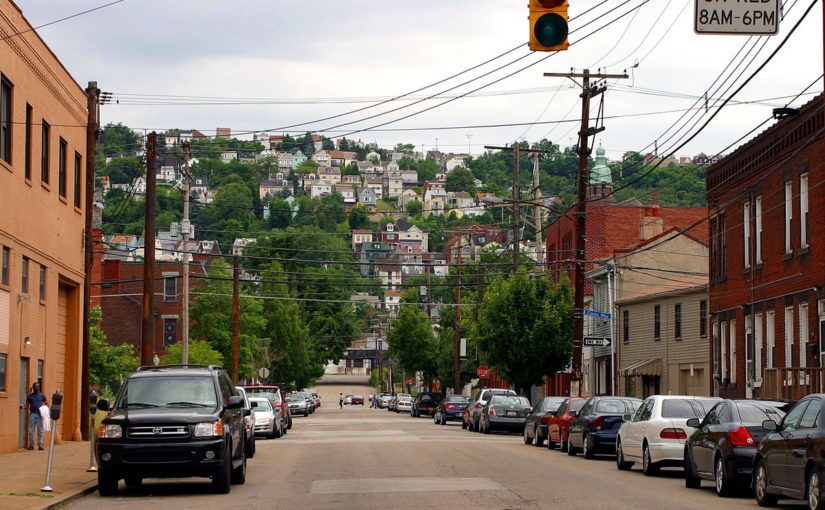








































That’s one of the best stories I have read about the 60-70’s. .
One point you missed was we entitled the blacks to get all the freebies because they were to dam-lazy to earn thanks to our government and education system. Intergration truth be known was another giant government failure.
It resulted in white flight and the division we know have between whites and blacks.
It is worse then it was before the civil war.
Thank you. Oh, you are so right about how the freebies created the society that we have today. We are watching the collapse of the give-away nation. It’s terrible. I have to write about this, and it’s on my big list of things to do. There has been so many failures in government that I could devote the entire blog to that subject alone. Thank you for your praise and a great big thank you for your insight.
Thanks for a refreshing recollection of days gone by. We were much alike as kids, you and I. Having grown up at the same time in southeastern Ohio in the foothills of the Appalachians , we shared many of the same experiences and I actually laughed aloud at the Farrah Faucett poster, Mad Scientist Club and brothers Daryl, Daryl and Daryl.
I share your thoughts on the current state of young men. I am proud to state that my ‘red-neck’ boys are all hard-working, God fearing family men who still get their hair cut at the barber shop.
With much respect …
What a wonderful comment. Nothing makes me happier than to hear that your boys are good, hard workers and who are firmly grounded in faith. Best wishes to you and yours.
https://www.returnofkings.com/ check out this website for more info on male female relationship dynamics.
Thank you for this. It’s one of my bookmarked sites and while the author tends to be a bit radical, I can easily see his points, which tend to be accurate, but abrasively expressed. Reread that sentence. Unfortunately he has gotten a lot of undeserved criticism. Which is sad as he is really trying to tell you the way things really are. I once posted some of his articles on Free Republic, and that got me temporarily banned for a month. The article inflamed some women, I guess. The truth is never pretty. Especially when it forces you to eject from your comfortable echo chamber.